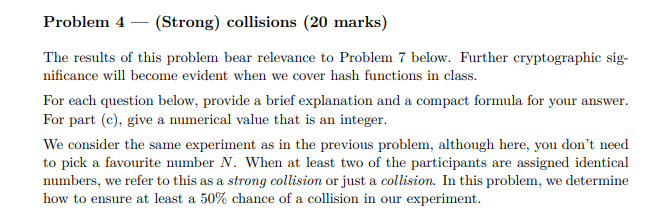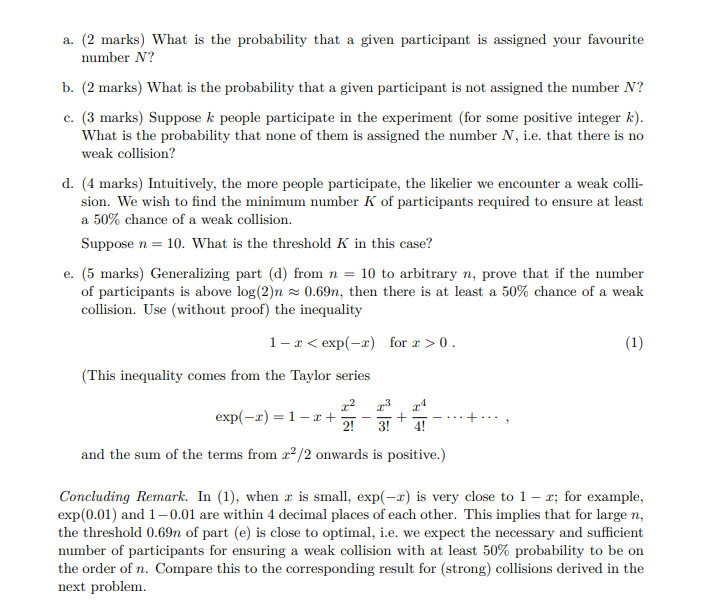

Problem 4 (Strong) collisions (20 marks) The results of this problem bear relevance to Problem 7 below. Further cryptographic sig- nificance will become evident when we cover hash functions in class. For each question below, provide a brief explanation and a compact formula for your answer. For part (c), give a numerical value that is an integer. We consider the same experiment as in the previous problem, although here, you don't need to pick a favourite number N. When at least two of the participants are assigned identical numbers, we refer to this as a strong collision or just a collision. In this problem, we determine how to ensure at least a 50% chance of a collision in our experiment. a a. (2 marks) What is the probability that a given participant is assigned your favourite number N? b. (2 marks) What is the probability that a given participant is not assigned the number N? c. (3 marks) Suppose k people participate in the experiment (for some positive integer k). What is the probability that none of them is assigned the number N, i.e. that there is no weak collision? d. (4 marks) Intuitively, the more people participate, the likelier we encounter a weak colli- sion. We wish to find the minimum number K of participants required to ensure at least a 50% chance of a weak collision. Suppose n = 10. What is the threshold K in this case? e. (5 marks) Generalizing part (d) from n = 10 to arbitrary n, prove that if the number of participants is above log(2)n = 0.69n, then there is at least a 50% chance of a weak collision. Use (without proof) the inequality 1-1 0. (1) (This inequality comes from the Taylor series 22 23 . exp(-x) = 1 2 + 2! 3! and the sum of the terms from 22/2 onwards is positive.) Concluding Remark. In (1), when x is small, exp(-2) is very close to 1 - r; for example, exp(0.01) and 1-0.01 are within 4 decimal places of each other. This implies that for large n, the threshold 0.69n of part (e) is close to optimal, i.e. we expect the necessary and sufficient number of participants for ensuring a weak collision with at least 50% probability to be on the order of n. Compare this to the corresponding result for strong) collisions derived in the next problem. Problem 4 (Strong) collisions (20 marks) The results of this problem bear relevance to Problem 7 below. Further cryptographic sig- nificance will become evident when we cover hash functions in class. For each question below, provide a brief explanation and a compact formula for your answer. For part (c), give a numerical value that is an integer. We consider the same experiment as in the previous problem, although here, you don't need to pick a favourite number N. When at least two of the participants are assigned identical numbers, we refer to this as a strong collision or just a collision. In this problem, we determine how to ensure at least a 50% chance of a collision in our experiment. a a. (2 marks) What is the probability that a given participant is assigned your favourite number N? b. (2 marks) What is the probability that a given participant is not assigned the number N? c. (3 marks) Suppose k people participate in the experiment (for some positive integer k). What is the probability that none of them is assigned the number N, i.e. that there is no weak collision? d. (4 marks) Intuitively, the more people participate, the likelier we encounter a weak colli- sion. We wish to find the minimum number K of participants required to ensure at least a 50% chance of a weak collision. Suppose n = 10. What is the threshold K in this case? e. (5 marks) Generalizing part (d) from n = 10 to arbitrary n, prove that if the number of participants is above log(2)n = 0.69n, then there is at least a 50% chance of a weak collision. Use (without proof) the inequality 1-1 0. (1) (This inequality comes from the Taylor series 22 23 . exp(-x) = 1 2 + 2! 3! and the sum of the terms from 22/2 onwards is positive.) Concluding Remark. In (1), when x is small, exp(-2) is very close to 1 - r; for example, exp(0.01) and 1-0.01 are within 4 decimal places of each other. This implies that for large n, the threshold 0.69n of part (e) is close to optimal, i.e. we expect the necessary and sufficient number of participants for ensuring a weak collision with at least 50% probability to be on the order of n. Compare this to the corresponding result for strong) collisions derived in the next








